27 Headstones That Defied Expectations
Consider this your burial marker mood board.
A grave marker is how people will remember you long after everyone you know has passed, so you’d better make it good. When done well, it can provide a sense of one’s style in life. The epitaph should be pithy, the shape and style memorable. You could go for the classic granite slab, or, like these deceased, opt for something a little more memorable.
To bury oneself under a headstone in the shape of a shark, say, or a palace-sized tomb carved out of a giant boulder, you’d have to be a little extraordinary. Often the stories that accompany these tombstones are larger than life. And death too, for that matter.
1. John Paul Jones’ Crypt
ANNAPOLIS, MARYLAND
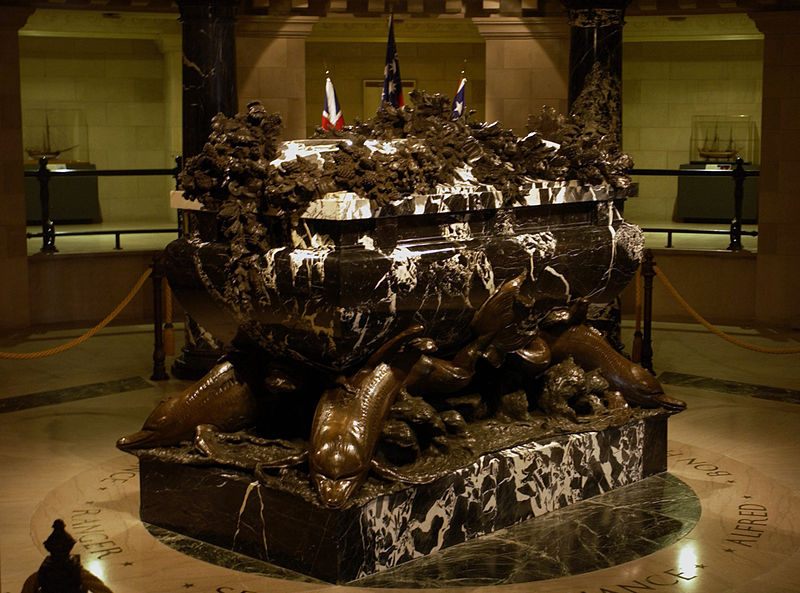
The crypt of John Paul Jones on display at the United States Naval Academy. (Photo: Kevin H. Tierney/US Navy/Public Domain)
John Paul Jones was the father of the American Navy, best known for shouting, “I have not yet begun to fight!” in response to a request for his surrender during a Revolutionary War battle. Less well known is the fact that for over a century after his death, the location of Jones’ body remained a mystery. Following his victories with the American Navy, Jones soon found his employment opportunities in America running dry. He joined up with the Russian Imperial Navy for a time, until he retired to Paris. Jones died there and was buried in a cemetery belonging to the French royal family. This property changed hands and Jones was forgotten. It wasn’t until 1905 that Jones’ remains were rediscovered by America’s Ambassador to France and returned to the United States.
Today, Jones rests in a extravagant sarcophagus below the chapel of the United States Naval Academy. The incredible coffin is covered in sculpted barnacles and is held up by bronze dolphins. The whole thing is sculpted out of a black and white marble that makes it look as though it has been weathered by untold ages beneath the waves—not so far from the truth.
2. Davis Memorial
HIAWATHA, KANSAS

Davis and his wife Sarah in old age. (Photo: Ammodramus/Public Domain)
The Davises were a simple but highly successful Kansas farming family. When Sarah Davis passed way in 1930 her burial site was marked with a simple headstone that reflected the quiet life she and her husband had led, despite the vast wealth they had accrued. But soon after Sarah had been placed in the ground, John had her stone removed and replaced with a marble statue, which was just the beginning. Over the next decade John installed 11 total marble or granite statues, many of which depicted Sarah as a young woman, an old woman, and even as an angel. There was also a statue of John resting in comfortable armchair next to an identical, empty armchair. All of these are arranged in a haphazard manner, facing in all different directions.
The cost of the memorial became astronomical, which upset a great number of Hiawathans suffering under the poverty of the Great Depression in a small town that did not even have a hospital. Many believed that John was simply trying to squander his fortune so that Sarah’s family, who had always hated the man, could not touch it. Still others believed that he was simply an eccentric with a permanently broken heart.
3. Jules Verne’s Tomb
AMIENS, FRANCE
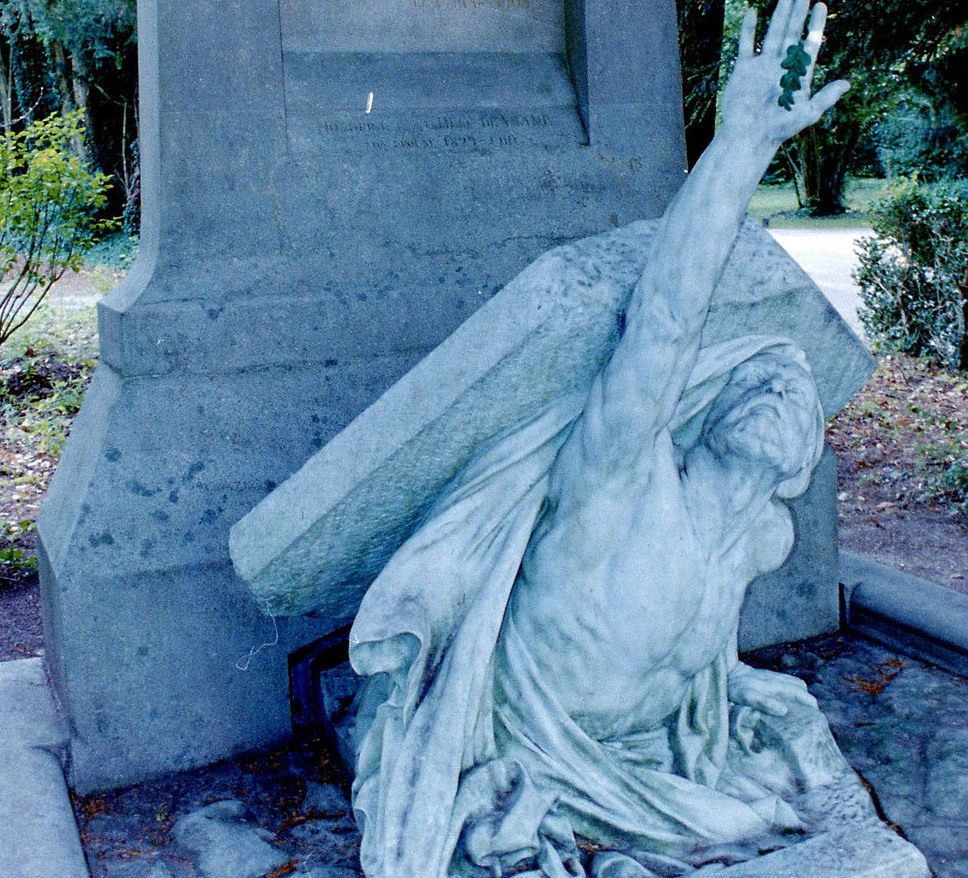
Jules Verne’s tomb. (Photo: Atlas Obscura user rogerbcn)
It’s fitting that Jules Verne, father of science fiction, would have a dark, otherworldly gravestone. Two years after his death a sculpture entitled “Vers l’Immortalité et l’Eternelle Jeunesse” (“Towards Immortality and Eternal Youth”) was erected atop his marker. Designed by sculptor Albert Roze, and using the actual death mask of the writer, the statue depicts the shrouded figure of Jules Verne breaking his own tombstone and emerging from the grave.
The effigy has become iconic enough that in first issue of seminal science fiction magazine Amazing Stories (first published in 1926) and for many years thereafter a drawing of his tombstone appeared as part of the masthead.
4. Jesus in Cowboy Boots
PARIS, TEXAS

Willet Babcock’s grave, topped by Jesus in cowboy boots. (Photo: Library of Congress/Carol M. Highsmith/LC-DIG-highsm-26027)
Willet Babcock was a furniture and casket maker by trade, and ended up in Paris, Texas where his factory and downtown store put him squarely in the center of respected Parisians. Before he died, in 1881, he ordered himself an impressive memorial from a master-stonecutter, a German immigrant named Gustave Klein, who carved some of the more ornate markers at Evergreen. Along with some typical memorial elements—carved wreaths, a cross, an angelic figure in robes—Babcock gave his final presentation to the world a little Texas twang. Jesus is sporting cowboy boots.
There is debate about whether it really is Jesus. Some say the face is too feminine (there is no beard) and he (she?) appears to be leaning on the cross rather than carrying it. But whoever the angel in robes was intended to represent, the memorial has long since been dubbed “Jesus in Cowboy Boots.”
5. Lycian Rock Tombs
FETHIYE, TURKEY

One of the impressive rock tombs. (Photo: Atlas Obscura user skaremedia)
The Ancient Lycians believed that their dead were carried to the afterlife by angels from the heavens. To facilitate this ascent they placed their honored dead in geographically high places, like this cliffside. The tombs, many of which date back to the 4th century, are guarded by massive entryways adorned with tall Romanesque columns and intricate reliefs. The oldest tombs are often no more than unremarked holes dug into the rock. Despite the external grandeur, the interior of the tombs are spare chambers cut into the rock with a simple monolith inside to display the body. The rooms are otherwise empty from hundreds of years of looting.
6. The Snow Tomb of Captain Robert Falcon Scott
ANTARCTICA

The grave of Scott and his men. (Photo: Herbert Ponting/Public Domain)
In November 1912, the remaining members of Captain Robert Falcon Scott’s Terra Nova expedition were searching for their leader. Scott and his party had vanished into the snows the previous year, never returning from their quest for the South Pole. One of the group saw “a small object projecting above the surface” of the snow. It was part of a tent. They had discovered the final resting place of Scott and two of his men, Henry “Birdie” Bowers and Edward Wilson. Scott lay between them, his diary recording their final days: “It seems a pity, but I do not think I can write more,” the last entry ran, “For God’s sake look after our people.”
The bodies of Scott and his men were not brought back to Britain. Instead, wrote Cherry-Garrard, who had been part of the search party, “We never moved them. We took the bamboos of the tent away and the tent itself covered them. Over them we built the cairn.” This tomb of snow, topped with a stark cross, was all that marked the remote spot in the Antarctic emptiness which has not been seen for over 100 years. The grave site was quickly buried in drifting snow, while the tent and bodies have been migrating downward into the ice under the weight of accumulating snow and seaward with the ice shelf toward the Ross Sea. A more permanent monument to Scott and his men was erected on Observation Hill near McMurdo Station, but given time, it is likely that, encased deep within an iceberg, the bodies of Scott, Bowers, and Wilson will slowly drift away out to sea.
7. The Tomb of Enrique Torres Belón
LAMPA, PERU

Inside Belón’s strange tomb. (Photo: Atlas Obscura user slsteinb)
Lampa is a small colonial town with all the provincial charms of a 16th century Peruvian town, but what stands out the most is its enormous church, the Iglesia Santiago Apóstol. Connected to the church is Enrique Torres Belón’s freaky mausoleum, a silo of bones capped by an aluminum replica of Michelangelo’s Pietà.
Belón, an engineer and architect, designed and built the tomb in the mid-20th century so that he and his wife could rest in peace surrounded by the earthly remains of the city’s forbearers. The otherworldly tribute is lined with hanging human skeletons and hundreds of skulls exhumed from the town’s cemetery and the crypts beneath the church. At the bottom is a black marble cross, whose lighting exaggerates the eerie shadows cast by the macabre wall hangings. The dramatic grave makes Belón seem very important—all Lampa’s founders are looking upon him for all eternity.
8. Mrs. Chippy Monument
WELLINGTON, NEW ZEALAND

Mrs. Chippy atop Harry McNeish’s grave. (Photo: Atlas Obscura user sandwichgirl)
Early polar exploration was a lonely business where sailors would be stuck on their ships for months, subsisting on barely edible rations among some of the world’s most inhospitable climates. However, the Shackleton expedition was made just a bit brighter by the presence of the ship’s cat, Mrs. Chippy. Harry McNeish was a carpenter on Ernest Shackleton’s Endurance expedition to Antarctica, as well as a member of the long journey from Elephant Island to South Georgia. He was also the primary caretaker of Mrs. Chippy, the cat that accompanied the men until the Endurance became trapped in pack ice. Unfortunately Mrs. Chippy was shot along with the sled dogs once the team became trapped in the ice. To honor the brave, beloved kitty, the New Zealand Antarctic Society added a bronze statue of Mrs. Chippy to McNeish’s grave in 2004.
9. Circus Train Wreck Victims Memorial
COLUMBUS, GEORGIA

The Big Top-shaped headstone for the victims of the circus train wreck. (Photo: Atlas Obscura user mom0ja)
The Con T. Kennedy Carnival Show had just wrapped up an unusually successful Harvest Festival week in the center of Atlanta. On the early morning of November 22, 1915, the 28-car Kennedy show train pulled out of the station with the entire company on board. Just a few hours later the show train collided with a steel passenger train. The crash was so powerful that the two engines fused together. While no one was killed on the sturdier passenger train, the Kennedy performers were not so lucky. “I saw those poor fellows pinned in their sleeping wagons and they could not get out,” one eyewitness recalled.
The fire raged for hours. When the smoke had finally cleared, bodies were discovered in the wreckage. At least 50 Kennedy workers were injured. Due to the transient nature of show people, the exact number and identity of those killed has never been determined. After a mass funeral at Columbus’s First Baptist Church, there was a procession to Riverdale Cemetery where the burials took place. Since the carnival band’s instruments had been burned, local Columbians loaned them instruments so they could send their comrades off in style.
In honor of his fallen employees, Con. Kennedy erected an appropriately circus-y monument in Columbus’ Riverdale Cemetery, and then he and the rest of his remaining crew headed back down the long, hard, show business road.
10. The Grave of Tom Thumb
TATTERSHALL, ENGLAND

The diminutive grave of Tom Thumb. (Photo: Thozza/CC BY-SA 3.0)
Nestled in the quaint Lincolnshire countryside is the village of Tattershall where, according to legend, the remains of a miniature folk hero can still be found. Visitors who step inside the town’s 16th century church will find a tiny grave marker, adorned with flowers and bearing the name Tom Thumb. He was reputedly just over 18 inches tall and lived to the ripe old age of 101 when he passed away in 1620.
It’s difficult to pick fact from fiction because Tom Thumb has been a common character in English folklore for hundreds of years, with the first written examples of his escapades appearing in the early 1500s. Traditionally, the character of Tom Thumb was a canny, cunning boy who used his size to trick and beguile foolish people. There are rumours that the Tom Thumb buried at Tattershall was popular with the King’s court and often visited London. Whether or not this is true and whether or not a man named Tom Thumb really is buried in that small church, it’s safe to say that his story has become forever intertwined with wider folklore. This charming little grave is now part of that.
11. William G. Bruce’s Grave
MONT VERNON, NEW HAMPSHIRE

The hound who guards the grave of William G. Bruce. (Photo: Atlas Obscura user GregBoggis)
William G. Bruce’s family had deep roots in the Town of Mont Vernon. He was an avid hunter and suffered a grave wound while hunting alone in 1883. He died the same day of his accident, but not before his wife Augusta Whittemore Bruce was rushed to his deathbed. William Bruce was industrious and frugal in life and left his wife a substantial sum of money. Augusta Bruce used some of this inherited wealth to commission noted monument maker Peter Brennan to craft a fitting memorial for her departed husband.
The book Lives Once Lived Here contains a facsimile of a ledger page that reveals Mrs. Bruce paid $35.00 each for the two headstones for her and her husband and $145.00 for the granite dog (a couple thousand in today’s dollars), who has remained faithfully by his master’s side in perpetual vigilance as his stone guardian in the afterlife.
12. The Grave of Miss Baker
HUNTSVILLE, ALABAMA

Miss Baker’s grave, topped with bananas from visitors. (Photo: Atlas Obscura user treytatum)
Miss Baker, a monkey purchased by NASA from a Miami pet shop, was the first primate to return alive from space. She and another monkey, Miss Able, were fitted with adorable little caps and jackets to wear into space and crammed into less than adorable metal monitoring capsules. Then in the wee hours of May 28, 1959, the duo were placed into a Jupiter rocket and shot 300 miles into the sky. The flight only lasted 16 minutes, over half of which consisted of weightlessness, and the rocket landed safely, for the first time, in the Atlantic Ocean.
She retired to the Naval Aerospace Medical Center in Pensacola where she was married to another monkey, Big George. Miss Baker died of kidney failure in 1984 at the age of 27, earning her the secondary honor of being the longest lived squirrel monkey on record. She has the honor of being buried in a grave outside of the U.S. Space & Rocket Center in Alabama and given a proper headstone next to her first husband. The grave is located in the center’s parking lot, but admirers and fans of the little astronaut still come by and leave bananas on her headstone.
13. The Tomb of Jane Griffith
BROOKLYN, NEW YORK

“To Jane my wife.” (Photo: Atlas Obscura user Luke J. Spencer)
Jane Griffith’s grave depicts a commonplace domestic scene with a tragically sorrowful ending. Charles Griffith says goodbye to his wife Jane on the footsteps of their brownstone on 109 West 13th Street. It is the morning of August 3rd, 1857, and he is about to leave for a typical day’s work, starting with a commute on the 6th Avenue horse trolley which waits on the corner. When Charles returned home from work, he found his wife dead from heart failure.
The artist’s detail is extraordinary, from the iron fencing to their pet dog waiting on the top step of the brownstone. Simply titled to “Jane my Wife,” the monument captures poignantly the morning Charles said farewell to his wife without knowing that it was for the last time.
14. Hi Jolly Monument
QUARTZSITE, ARIZONA

The grave of the U.S. government’s first official camel rider. (Photo: Atlas Obscura user Avoiding Regret)
During the mid-1800s when much of the southwest of America was still uninhabited desert, the government decided they would deal with the terrain like the desert dwellers of the Middle East and hire camel drivers, such as Hi Jolly, to carry their goods across the arid terrain. He was born Philip Tedro in Syria, converted to Islam and changed his name to Hadji Ali, which the Americans of the U.S. Cavalry pronounced as “Hi Jolly.” They contracted him to be the first member of the experimental Army Camel Corps. Jolly stood out from the rest of the riders for both his ambition and his cantankerous attitude.
Eventually the camel corps was disbanded after it was found that the much larger camels spooked the native livestock and horses. Jolly remained in the states before passing away in Arizona in 1902. Today his grave is marked by a stony pyramid that is topped by an etched metal camel.
15. Grave of Joseph Palmer
LEOMINSTER, MASSACHUSETTS

“Persecuted for wearing the beard.” (Photo: Atlas Obscura user kensears37)
Joseph Palmer began wearing a beard in the 1820s, in spite of the fact that beards had been out of fashion for nearly a century. Palmer was considered by most all in his small town to be slovenly and ungodly. He was even criticized by his local preacher for communing with the devil, famously responding to the accusation, “…if I remember correctly, Jesus wore a beard not unlike mine.”
In May of 1830, Palmer was attacked by four men outside of a hotel in Fitchburg, Massachusetts. Armed with razors and scissors, the men attempted to forcibly shave Palmer’s face, but the bewhiskered man stabbed two of his attackers with a pocketknife, and was subsequently arrested for assault. He could have avoided jail by paying a fine and court fees, but Palmer refused, maintaining his innocence, and more importantly his right to a glorious beard. He was subsequently jailed for 15 months, including time in solitary confinement.
Upon leaving prison, Palmer joined the Fruitlands utopian community in nearby Harvard, Massachusetts after being influenced by his friendship with fellow Fruitlander, Louisa May Alcott, who wrote a character based on him. Palmer died in 1865 and his tombstone displays a portrait of him with a long beard, a final act of rebellion.
16. Merchant Ball
MARION, OHIO

The mysterious Merchant ball. (Photo: Atlas Obscura user markallender)
The Merchant family were prominent industrialists in Ohio, and when they erected this massive sphere in 1896 to mark the grave of Charles Merchant it matched the style and fortitude of the clan. The giant granite ball was placed atop a stone plinth and polished and stained to a fine shine, except for the circle where the ball rested on its stand. Within a few years of its installation the sphere had mysteriously begun to slowly rotate on its pedestal, eventually revealing the bald spot.
The estimated 5,200 pound ball had not been secured to the base, thinking the huge amount of friction would have simply held it in place. At one point, Merchant descendants attempted to right the sphere, securing it with tar. Despite all this, the stone has managed to continue spinning on its pedestal. No one is quite sure why the sphere keeps moving, be it from imperceptible vibration or ghostly intervention as some would have it. But no matter the cause, the Merchant ball rolls on.
17. Nicolas Cage’s Pyramid Tomb
NEW ORLEANS, LOUISIANA

The empty tomb, waiting for Nicolas Cage. (Photo: Britt Reints/CC BY 2.0)
There are plenty of pyramid tombs, but most date to the 19th century and earlier. This one is not only modern, but empty. Actor Nicolas Cage purchased a plot in the famous St. Louis Cemetery No. 1 and erected a stark, nine-foot-tall stone pyramid for himself. There is no name on the pyramid yet, but it is emblazoned with the Latin maxim, “Omni Ab Uno,” which translates to “Everything From One.” The actor himself has chosen to remain silent about his reasoning for the flamboyant tomb. Some speculate it’s an homage to the “National Treasure” movie franchise. Others think the pyramid is evidence of the strange actor’s ties to the probably-fictitious secret Illuminati society. The more paranormally minded suggest that the pyramid is where Cage will regenerate his immortal self.
Whatever his reasons, the Cage pyramid has already become an iconic part of the cemetery, much to the chagrin of many locals who are furious that he was able to obtain a plot in the cramped graveyard. Many have even accused the tomb of damaging or removing other centuries-old burials to make room.
18. Grave of Harry L. Collins
LOUISVILLE, KENTUCKY

The grave of Frito-Lay’s corporate magician, Harry L. Collins. (Photo: Atlas Obscura user Matt Blitz)
Harry Collins was a lifelong magic lover, and even performed in jazz musician Bob Crosby’s traveling USO show, “This Is The Army Show” during World War II. After serving, Collins returned to the United States, moved to the big city, and got a job as a salesman at Frito-Lay, the purveyor of many a fine snack food. For the next twenty years, he was a Frito-Lay man by day and “Mr. Magic,” Louisville’s most popular magician, by night. He was so dedicated to both professions that the magic word for every one his tricks was “Frito-Lay!”
In 1970, Frito-Lay named Mr. Magic their official corporate magician. He traveled across the country and world, performing magic tricks and paying homage to his beloved company. Now his effigy stands atop his grave, extending an arm to welcome visitors into his world of corn chips and wonder.
19. Afterglow Vista
FRIDAY HARBOR, WASHINGTON

“Afterglow Vista,” a fantastical mausoleum steeped in symbolism. (Photo: Atlas Obscura user thendaramarie)
Its formal name is McMillin Mausoleum, named for John S. McMillin, Freemason, Methodist, and lime works businessman. He combined all of these devotions when he constructed the epic mausoleum that would house the remains of he and his family’s remains, Afterglow Vista, the name which is actually placed on the stone arch leading to the burial site.
The so-called “mausoleum” is actually an open air rotunda with a huge limestone table in the middle. Around the table are thick stone chairs not only representing the members of the McMillin family, but actually containing their ashes and acting as headstones. This was meant to represent the family dinner table that the McMillins would rather around. There seems to be an empty space at the table and it is said that this was meant to represent the McMillin son who turned away from God. The table is circled by six Roman columns and a single broken column which is said to represent the unfinished nature of man’s life. The columns were originally going to hold a brass dome over the table, but in the end the family opted to leave the site exposed to the elements. Even the steps leading up to the monument were numbered with Masonic significance to represent the stages of life.
20. Cursed Memorial of Colonel Buck
BUCKSPORT, MAINE

The cursed stain on the Buck memorial. (Photo: Courtesy of J.W. Ocker)
Bucksport’s founder, Colonel Jonathan Buck, had a witch executed in the town’s early days. Before she died, she cursed Buck to always bear the mark of that deed. One story says that while she was burning at the stake, her leg fell from her body and into the crowd, and this stain has appeared to remind everyone of the gruesome event. Whatever the story, Bucksport is left with a pointy stocking-shaped stain on an obelisk of granite in a hilltop graveyard on Main Street, dedicated to the founder of the town. It hangs right below his name like a stocking on a fireplace.
21. Gravesite of Utah’s First Jedi Priest
WEST VALLEY CITY, UTAH

“May the force be with you–always.” (Photo: Atlas Obscura user jbbutcher79)
In sleepy Valley View Memorial Park there is a treasure the first of its kind in Utah. Hidden in the Southwest corner of the cemetery is an onyx-colored plaque in the ground that is hard to ignore. It reads, “Steven Allan Ford April 7, 1980-September 7, 2010 MAY THE FORCE BE WITH YOU–ALWAYS.” This is no overzealous fan, but indeed the resting place of someone remarkable: Steven Ford, the first ordained Jedi priest in the predominantly Mormon state of Utah.
22. The Strange Procession Which Never Moves
MAYFIELD, KENTUCKY
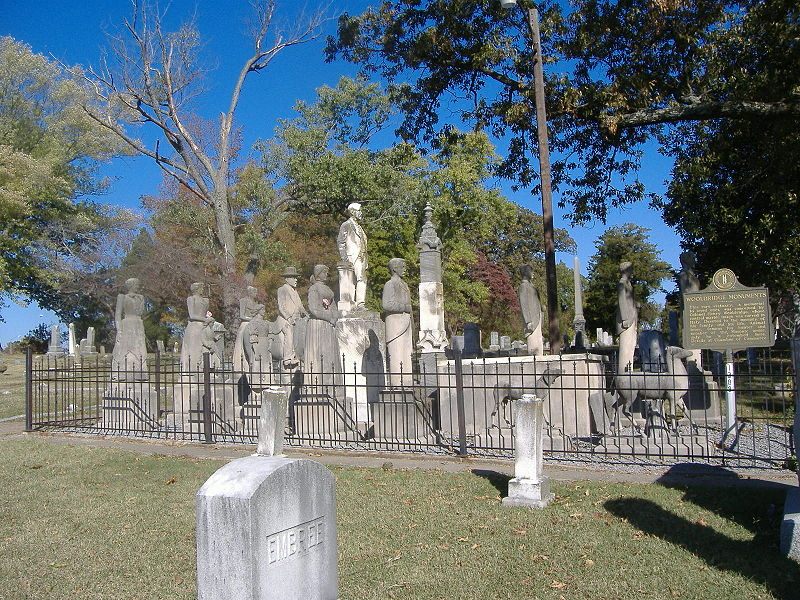
Colonel Woolridge’s private statuary. (Photo: C. Bedford Crenshaw/Public Domain)
This might look like a small, private cemetery within Maplewood Cemetery, but it is actually the grave of just one man, Colonel Henry G. Wooldridge. It was built over the course of seven years until Wooldridge’s own death in 1899, and commemorates family members and other loved ones Wooldridge lost over the course of his lifetime. The figures include his mother and sisters and his horse named Fop.
Prompted by no one but his own aching heart, the man spent his last years pouring his fortune into immortalizing all that was irretrievably lost in stunning fashion. After more than a century of visitation by a public fascinated by the spectacle, the site has acquired an unofficial, completely disconcerting name: “The Strange Procession Which Never Moves.”
23. Ämari Pilots Cemetery
ÄMARI, ESTONIA

The grave of an Estonian pilot. (Photo: Robert Treufeldt/CC BY-SA 3.0 ee)
Tucked into the scrubby woods near Estonia’s Ämari Air Base is a pilot’s graveyard where Soviet airmen are buried beneath the fins of the very aircraft they likely died in. While some of the graves are crude and simple affairs, the graves of the many of the military pilots are topped with actual tail fins from Russian aircraft. These are dedicated to pilots who flew and died when Estonia was part of the Eastern Bloc until the dissolution of the Soviet Union in 1991. The stark opposition and funereal atmosphere turn the site into a haunting memorial not just to the fighting men buried at the site, but for Estonia’s past as well.
24. The Haserot Angel
CLEVELAND, OHIO

The weeping angel on Francis Haserot’s tomb. (Photo: Ian MacQueen/CC BY-SA 3.0)
Perhaps the most famous statue at Lakeview Cemetery is “The Angel of Death Victorious” seated on the marble gravestone of one Francis Haserot. The life-size bronze angel holds an upside-down torch, a symbol of life extinguished. Perhaps its most unsettling feature, however, is how the statue appears to be weeping black tears at all times. These “tears” formed over time, an effect of the aging bronze combined with the impressive sculpting work of the piece itself. This lacrimal feature attracts a number of visitors and tourists each year.
25. The Recumbent Effigy of Victor Noir
PARIS, FRANCE

Victor Noir’s romantic effigy in Père Lachaise Cemetery. (Photo: Atlas Obscura user allison)
Victor Noir was a 19th-century political journalist shot in a duel by Prince Pierre Bonaparte in 1870. He became a symbol of the imperial injustice and a martyr for the Republic. More than one hundred thousand people came to his funeral, where frenetic weeping was mixed with calls for insurrection. After the downfall of the Second Empire, Victor Noir’s remains were transferred to the Père Lachaise Cemetery, and a bronze effigy was commissioned.
Noir was depicted as an elegant man, lying dead on the floor after the impact of the lethal bullet, his top hat tipped over on his side. Dalou chose to represent Noir in a very realistic way, his face having the detailed quality of a cast death mask. However, another detail of Noir’s anatomy would soon get more attention than the sober realism of the memorial bronze.
Victor’s grave remains one of the most popular at Père Lachaise, but not because of his political symbolism. Generations of women have come to kiss his lips and rub his bulge, believing it will bring good luck. After a century and a half of this action, Victor Noir’s lips and groin are shiny and nickel-clean, while the rest of his body presents the greenish tone of oxidized bronze.
26. The Grave of Rope Walker
CORSICANA, TEXAS

The grave of the peg-legged Jewish rope walker. (Photo: Atlas Obscura user seh256)
It’s not his name, but rather his profession. Rope Walker was a peg-legged tightrope walker who died in 1884, when he fell from a rope stretched across one of the town’s main streets with an iron stove strapped to his back. He asked for a rabbi as he was dying, but he did not reveal his name. Using the scant information they had about him, the townspeople buried him as “Rope Walker” in the Hebrew Cemetery of Corsicana.
27. Minerva in Green-Wood Cemetery
BROOKLYN, NEW YORK

Minerva waves to Lady Liberty from Battle Hill. (Photo: Atlas Obscura user allison)
Life-sized monuments are not so uncommon, but this one is half of a statue friendship. In 1920, Charles M. Higgins, an Irish immigrant and local history buff built an altar on Battle Hill to the long-slighted Revolutionary War Battle of Long Island, the first major battle after the Declaration of Independence. He chose to top the monument with a statue of Minerva, the Roman goddess of wisdom. As if to communicate between past and present, Minerva’s outstretched arm reciprocated exactly 3.5 miles away by the Statue of Liberty’s raised torch. Their friendship has stood the test of time (and condo development) and their line of sight to each other remains unobstructed.




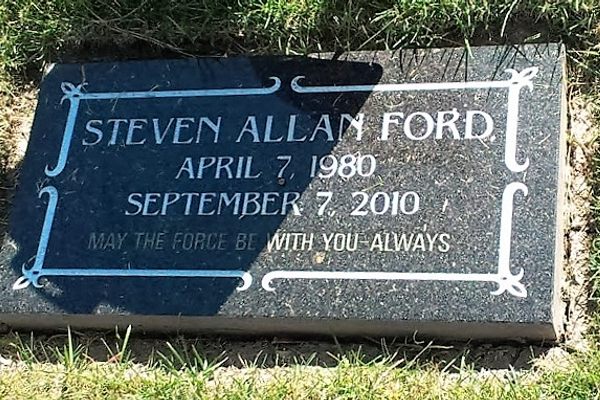


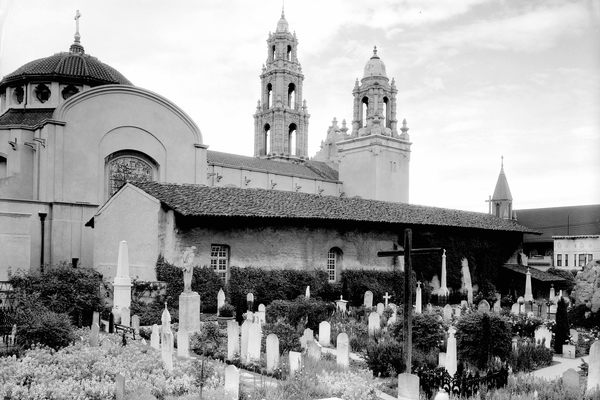
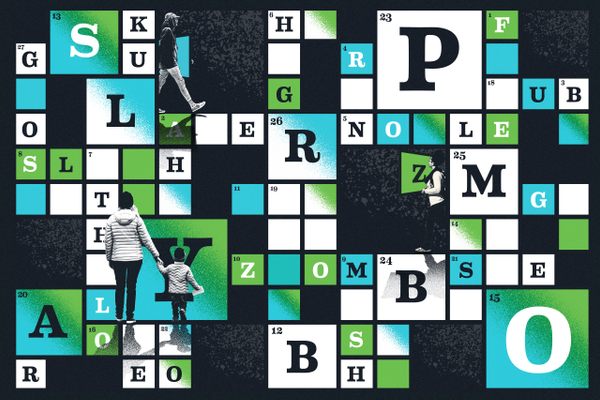











Follow us on Twitter to get the latest on the world's hidden wonders.
Like us on Facebook to get the latest on the world's hidden wonders.
Follow us on Twitter Like us on Facebook